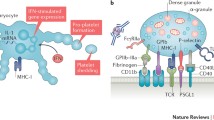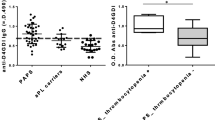Abstract
Systemic lupus erythematosus (SLE) is an autoimmune disease in which the body’s immune system mistakenly attacks healthy tissue. It can affect the skin, joints, kidneys, brain, and other organs. Blood cells, including platelets, are also involved in SLE and contribute to the pathogenesis of disease. We studied ultrastructure of platelets isolated from the blood of SLE patients and found that the plasma membrane was rough and shaggy compared to the normally smooth cell surface. These changes in the membrane morphology increased with the disease severity and were more pronounced when SLE was associated with the antiphospholipid syndrome, suggesting that platelets are strongly affected by the immune reactions underlying SLE.
Similar content being viewed by others
Avoid common mistakes on your manuscript.
1 Introduction
Systemic lupus erythematosus (SLE) is an autoimmune disease characterized by systemic inflammation affecting several organ systems including the joints, kidney, skin, and central nervous system. Antibodies directed against platelet membrane glycoproteins were shown to cause thrombocytopenia that is often observed in SLE [1, 4]. Despite reduced platelet count, SLE patients are predisposed to venous thrombosis and stroke [2], perhaps because of platelet activation revealed by expression of P-selectin and increased platelet aggregation [1]. In addition to the high risk of thrombosis, platelets that are activated by immune complexes formed in SLE can promote dendritic cell differentiation, which enhances the production of pathogenic autoantibodies and exaggerates the disease [1]. To provide a structural basis for the abnormal platelet functionality in SLE, we investigated morphology of platelets isolated from the blood of healthy donors and SLE patients using transmission electron microscopy.
2 Material and Methods
The study was approved by the Ethical Committee of Kazan State Medical University. Patients were included in the study based on the criteria of the American College of Rheumatology (ACR) for SLE. Citrated blood was collected by venipuncture from four SLE patients and three healthy aspirin-free donors and centrifuged at 200 g for 10 min at room temperature to obtain platelet-rich plasma. Platelet were isolated from the platelet-rich plasma by gel filtration on Sepharose 2B (GE Healthcare, Sweden) equilibrated with a modified Tyrode’s buffer.
Isolated suspended platelets (∼120 × 106/ml) were fixed in a 2 % glutaraldehyde solution in phosphate buffered saline (PBS) for 90 min. The fixed platelets were pelleted by centrifugation at 1000 g for 5 min at the room temperature. The pellet was washed with PBS, and the samples were postfixed with 1 % osmium tetroxide in the same buffer with addition of sucrose (25 mg/ml) for 2 h. The samples were dehydrated serially in 30, 50, 70, 50, 90, 95 vol% alcohol and then in acetone and propylene oxide. Epon 812 was used as the embedding resin. Samples were polymerized for 3 days under increasing temperature from 37 to 60 °C. Sections were obtained on an LKB-III ultramicrotome (Sweden). The sections were contrasted with saturated aqueous solution of uranyl acetate for 10 min at 60 °C and then with an aqueous solution of lead citrate for 10 min. The preparations were examined using a Jem1200EX electron microscope (Jeol, Japan).
3 Results and Discussion
All the SLE patients had normal red blood cell counts (4.6 ± 0.5 × 1012/l), and two of the four had a moderately high platelet count (320 × 109/l and 314 × 109/l). One patient with high leukocyte counts had a shortened activated partial thromboplastin time (aPTT), and one patient with the antiphospholipid syndrome (a high level of anticardiolipin antibodies) had a high platelet count combined with prolonged aPTT. The patient with SLE associated with the antiphospholipid syndrome also had a high level of the anti-beta-2-glycoprotein antibodies.
Using transmission electron microscopy, we examined morphology of 94 individual platelets from SLE patients and 60 cells from healthy donors. The platelets from healthy and SLE donors all had a discoid shape and were 1–3 μm in size (Fig. 1). Some platelets formed 1–2 short filopodia, but the vast majority of cells did not have protrusions. Intracellular components (α-granules, dense granules, open canalicular system, lysosomes, and mitochondria) were less clear in the platelets from SLE patients compared with normal platelets, but the overall structure of cytoplasm and intracellular organelles were unchanged.
a Ultrastructure of a resting platelet from healthy donors with normal plasma membrane. b A platelet from a SLE patient without the antiphospholipid syndrome that has abnormal rough plasma membrane. c A platelet from a SLE patient with the antiphospholipid syndrome that has more pronounced morphological changes appearing as rough and shaggy plasma membrane. Designations: α stands for α-granules, dg dense granules, and OCS open canalicular system. Arrows indicate the plasma membrane abnormalities. Scale bar is 500 nm
The biggest morphological difference between platelets from healthy subjects and SLE patients was revealed in the platelet plasma membrane. The membrane of “SLE platelets” was very often (in 54 % of the cells) shaggy and rough and not as smooth as in normal platelets (Fig. 1). In some platelets obtained from SLE patients (27 %), the membrane was only partially altered, and a substantial fraction of SLE platelets (19 %) did not have any alterations in the structure of plasma membrane. We noticed that the observed ultrastructural changes were more or less pronounced in one SLE patient versus another. A patient with the antiphospholipid syndrome who had prolonged aPTT had the most striking membrane abnormalities that were found in 100 % of platelets analyzed from this patient. There were no visible changes in the structure of plasma membrane in any platelet analyzed from the healthy donors [3]. We hypothesize that this anomalous structure of the cell membrane is due to a thicker layer of glycocalyx, including a higher content of glycosaminoglycans. These substances can be responsible for enhanced binding of antibodies or immune complexes to the cell surface and subsequent platelet activation through receptors, such as FcγRIIA or toll-like receptors [1]. Accordingly, the abnormal structure of the plasma membrane in SLE platelets can reflect massive deposition of immune complexes on the platelet surface.
4 Conclusion
Platelets from the SLE patients are morphologically different from normal cells with the main difference revealed in the structure of their plasma membrane. In SLE platelets, the plasma membrane is rough and shaggy, which is presumably due to a larger amount of glycocalix and/or deposition of immune complexes on the surface of the cells. These morphological changes are more pronounced in patients with severe SLE complicated with the antiphospholipid syndrome. The results indicate that platelets are strongly affected in SLE and can play an important pathogenic role in the course and outcomes of SLE and perhaps other autoimmune diseases.
References
Biolard, E., Blanco, P., Nigrovic, A. (2012). Platelets: active players in the pathogenesis of arthritis and SLE. Nature, 8, 534–542.
Vikerfors, A., Johansson, A. B., Gustafsson, J. T., Jonsen, A., Leonard, D. (2013). Clinical manifestations and anti-phospholipid antibodies in 712 patients with systemic lupus erythematosus: evaluation of two diagnostic assays. Rheumatology (Oxford), 52, 501–509.
Ponomarevaa, A. A., Nevzorova, T. A., Mordakhanova, E. R., Andrianova, I. A., Litvinov, R. I. (2016). Structural characterization of platelets and platelet microvesicles. Tissue Biology, 10(3), 217–226.
Macchi, L., Rispal, P., Clofent-Sanchez, G., Pellegrin, J. L., Nurden, P., Leng, B., et al. (1997). Anti-platelet antibodies in patients with systemic lupus erythematosus and the primary antiphospholipid antibody syndrome: their relationship with the observed thrombocytopenia. British Journal of Haematology, 98, 336–341.
Acknowledgments
This work was supported by the Program for Competitive Growth of Kazan Federal University.
Author information
Authors and Affiliations
Corresponding author
Ethics declarations
The study was approved by the Ethical Committee of Kazan State Medical University.
Rights and permissions
About this article
Cite this article
Andrianova, I.A., Ponomareva, A.A., Mordakhanova, E.R. et al. Abnormal Ultrastructure of the Platelet Plasma Membrane in Systemic Lupus Erythematosus. BioNanoSci. 6, 361–363 (2016). https://doi.org/10.1007/s12668-016-0239-4
Published:
Issue Date:
DOI: https://doi.org/10.1007/s12668-016-0239-4





